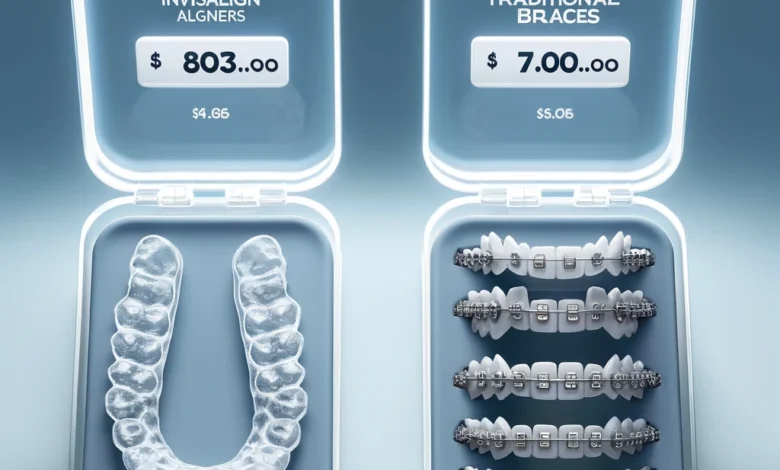Is Invisalign Cheaper Than Braces? A Comprehensive Cost Comparison for 2025

Average Costs in 2025
Let’s talk numbers. In 2025, traditional braces tend to range between $3,000 and $7,000. Invisalign, on the other hand, typically costs anywhere from $3,500 to $8,000. While there’s some overlap, Invisalign is often slightly more expensive. Why? It’s all about the technology and customization. That said, simpler cases might bring Invisalign costs closer to the lower end of the spectrum, making it comparable to braces.
| Treatment Type | Average Cost Range (2025) |
| Traditional Braces | $3,000 – $7,000 |
| Invisalign | $3,500 – $8,000 |
Geographical Variations in Pricing
Where you live can also make a huge difference in how much you’ll pay. Urban areas, with their higher cost of living, often come with steeper orthodontic fees. Meanwhile, rural regions might offer more affordable options. Even within the same city, prices can vary depending on the orthodontist and their clinic’s overhead costs. If you’re looking to save, it might be worth shopping around or even considering treatment in a nearby town.
Key Factors That Impact Invisalign and Braces Costs
Treatment Complexity and Duration
The severity of your dental issues plays a huge role in determining costs. For mild alignment problems, Invisalign might actually be cheaper than braces. But for more complicated cases that involve significant tooth movement or bite corrections, braces or additional Invisalign aligners may be required, which can drive up the cost. Treatment time also matters—Invisalign typically takes 12 to 18 months, while braces can last anywhere from 18 months to 3 years.
Materials and Technology Used
The materials and design of Invisalign and braces are different, and that affects the price. Invisalign aligners are made from custom, clear plastic using advanced 3D imaging technology, which can make them pricier. Braces, on the other hand, use either metal or ceramic brackets and wires. While ceramic braces are more discreet, they’re also more expensive than traditional metal ones.
Insurance Coverage and Payment Options
Insurance can make a big difference in what you end up paying. Some plans cover a portion of orthodontic treatments, but the specifics vary. Invisalign might not always be covered to the same extent as braces. Payment plans, discounts, or flexible spending accounts (FSAs) can also help ease the financial burden. Don’t forget to ask your provider about these options.
Invisalign and braces both have their pros and cons, but the total cost often depends on the complexity of your case, the materials used, and how you choose to pay.
Hidden Costs to Consider for Invisalign and Braces
Retainers and Post-Treatment Expenses
After completing your Invisalign or braces treatment, you’ll need retainers to maintain your new smile. Retainers can cost anywhere from $100 to $500 per set, and some orthodontists recommend replacing them every year or two. These expenses can add up over time, so it’s worth budgeting for them. Skipping retainers can lead to teeth shifting back, undoing the progress of your treatment.
Follow-Up Visits and Adjustments
Both Invisalign and braces require follow-up appointments. While Invisalign often involves fewer visits, these appointments can still cost $50 to $200 each, depending on your provider. Braces might need monthly adjustments, which could also mean additional charges. Don’t forget to account for these costs when estimating your total expenses.
Additional Fees for X-Rays and Impressions
Before starting treatment, you’ll likely need X-rays, impressions, or scans to map out your plan. These diagnostic tools can cost between $150 and $500. Some orthodontists include this in their treatment packages, but others charge separately, so be sure to ask upfront.
When planning for orthodontic care, understanding all potential expenses ensures no surprises down the line. From retainers to follow-ups, these costs can significantly impact your budget.
In summary, while Invisalign and braces might seem straightforward, hidden costs like retainers, follow-ups, and diagnostics can add up. If you’re also wondering “How Much Do Dentures Cost in Ontario,” you’ll notice that dental expenses vary greatly depending on the treatment and location. Always consult your orthodontist for a detailed breakdown of costs.
Comparing the Value: Is Invisalign Worth the Extra Cost?
Aesthetic and Comfort Benefits
One of the biggest reasons people choose Invisalign over traditional braces is its discreet appearance. The clear aligners are nearly invisible, making them a popular choice for adults and teens who want to avoid the metal-mouth look. Invisalign also offers a more comfortable experience, as the aligners are made of smooth plastic rather than sharp metal brackets and wires. This reduces the likelihood of irritation inside your mouth. Plus, since the aligners are removable, you can eat, drink, and brush your teeth without any hassle—a huge convenience compared to braces.
Maintenance and Oral Hygiene
Maintaining good oral hygiene is easier with Invisalign. Unlike braces, which can trap food particles around brackets and wires, Invisalign aligners can be removed for brushing and flossing. This means you’re less likely to deal with plaque buildup or tooth discoloration during treatment. Additionally, regular cleaning of the aligners themselves is simple—just rinse and brush them daily. For those wondering, “how much is Invisalign in Ontario?” keep in mind that the cost might be slightly higher than braces, but the ease of maintenance could make it worth it.
Patient Satisfaction and Reviews
Patient reviews often highlight the satisfaction of using Invisalign. Many users appreciate the shorter treatment times compared to braces, as well as the ability to see progress with each new set of aligners. If you’re debating, “is Invisalign worth it?”, consider that most people report high levels of confidence and happiness with their results. While the price can range from $3,500 to $8,000, depending on your case, the investment often leads to a healthier, straighter smile.
Invisalign delivers more than just straight teeth—it offers a lifestyle upgrade. The convenience and comfort make it a preferred option for many, even if it costs more upfront.
Exploring Alternatives to Invisalign and Braces
ClearCorrect and SmileDirectClub
If you’re looking for a more affordable option, ClearCorrect and SmileDirectClub are worth considering. ClearCorrect uses a similar clear aligner approach as Invisalign, but it often comes at a lower price point. SmileDirectClub, on the other hand, offers a more DIY approach, where you manage most of the process from home. However, this might not be suitable for complex dental issues. Both options use advanced tools like the iTero scanner to ensure a precise fit, but they might not offer the same level of in-person care as Invisalign.
Traditional Metal Braces
Metal braces are the classic choice and remain a reliable alternative. They are often less expensive than clear aligners and are particularly effective for severe alignment issues. While they may not be as discreet, modern designs have made them more comfortable and customizable. Plus, traditional braces can be paired with digital dental X-rays for a more accurate treatment plan.
Other Clear Aligner Brands
Apart from Invisalign, several other brands like Byte, AlignerCo, and Candid offer clear aligner solutions. These options can be more budget-friendly and sometimes faster, depending on your specific needs. For example:
| Brand | Price Range | Treatment Duration |
| Byte | $1,999 – $2,399 | ~4 months |
| AlignerCo | $945 – $1,145 | 4-6 months |
| Candid | $2,400 – $3,500 | ~6 months |
These aligners also rely on modern technology like digital dental X-rays and 3D imaging for accurate results.
While Invisalign in London Ontario, remains a popular choice, exploring these alternatives could help you save money or find a solution that better fits your lifestyle. Don’t forget to consult your orthodontist, especially if you’re also considering other treatments like dental implants in London, Ontario.
How to Save Money on Invisalign or Braces
Using Insurance Effectively
If you’re considering orthodontic treatment, insurance can be a big help. Many dental insurance plans cover part of the cost for Invisalign or traditional braces. Check with your provider to see if your plan includes coverage for cosmetic dentistry in London, Ontario, or related services. Some policies may offer up to $3,000 in benefits for orthodontic care. Make sure to understand your policy’s lifetime maximums and exclusions.
- Ask your insurance provider specifically about Invisalign coverage.
- Explore employer-sponsored dental plans for additional benefits.
- Consider government programs like Medicaid if you’re eligible.
Flexible Payment Plans and Discounts
Most orthodontists, whether you’re visiting a family dentistry in London Ontario, or a specialized clinic, offer flexible payment plans to spread out the cost. Some even provide discounts for paying in full upfront or for family members undergoing treatment together.
- Monthly payment plans with low interest rates.
- Discounts for upfront payments or multiple family members.
- Utilize tax-free accounts like FSA or HSA to save more.
Timing Your Treatment for Maximum Savings
Timing can also play a role in saving money. For example, some clinics offer seasonal promotions or back-to-school discounts. If you’re planning a smile makeover in London, ask your dentist about upcoming deals.
- Schedule consultations during promotional periods.
- Start treatment at the beginning of the year to maximize insurance benefits.
- Avoid peak times when clinics are busier and less likely to offer discounts.
Budgeting for Invisalign or braces doesn’t have to be overwhelming. By combining insurance, payment plans, and strategic timing, you can make orthodontic care more affordable. Whether you’re looking for an emergency dentist in London, Ontario, or planning for veneers, there are ways to save without compromising quality.
Remember, whether you’re asking “how long does it take to get dentures” or searching for a “dentist near me in London, Ontario,” planning ahead can make all the difference in cost and convenience.
Read also:Ontpress.com: Your Ultimate Financial Knowledge Hub
Conclusion: Choosing Between Invisalign and Braces
When it comes to deciding between Invisalign and traditional braces, the “cheaper” option really depends on your specific needs and priorities. Invisalign might cost a bit more upfront, especially for complex cases, but many people find the convenience and nearly invisible look worth the extra expense. On the other hand, braces are often the go-to for more severe alignment issues and can sometimes be more budget-friendly. Don’t forget to factor in things like insurance coverage, payment plans, and any extra costs like retainers or follow-up visits. At the end of the day, both options can help you achieve a straighter smile—it’s just about finding what works best for you and your wallet.





